MOD003327 Economics for Business: Cost-Benefit Analysis & UK Market
VerifiedAdded on 2023/06/13
|14
|3520
|346
Report
AI Summary
This report examines microeconomic principles, focusing on resource scarcity, opportunity costs, and cost-benefit analysis within the UK economy between 2019 and 2021. It defines scarcity as the disparity between limited resources and unlimited demands, necessitating efficient resource allocation. Opportunity cost is presented as the value of the next best alternative forgone when making a decision. The report uses real-world examples, such as vaccine shortages during the COVID-19 pandemic and personal financial decisions, to illustrate these concepts. It identifies challenges faced by households, including lack of education, urbanization pressures, financial illiteracy, the cost of ownership, and water scarcity. The report also discusses how businesses utilize cost-benefit analyses and incentives to drive profits, emphasizing the importance of understanding both internal and external costs. The document concludes by reinforcing the significance of these microeconomic concepts in personal and business decision-making.
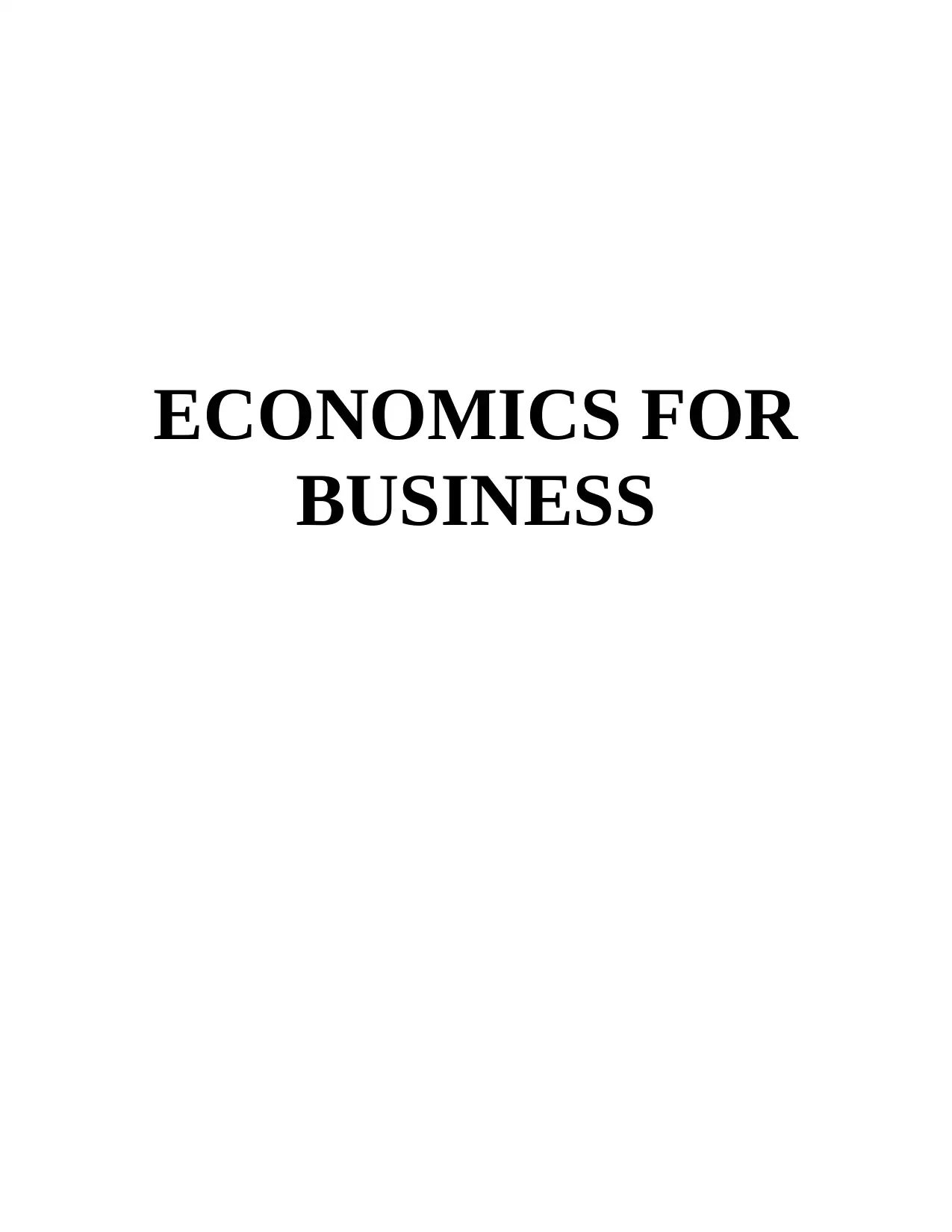
ECONOMICS FOR
BUSINESS
BUSINESS
Paraphrase This Document
Need a fresh take? Get an instant paraphrase of this document with our AI Paraphraser
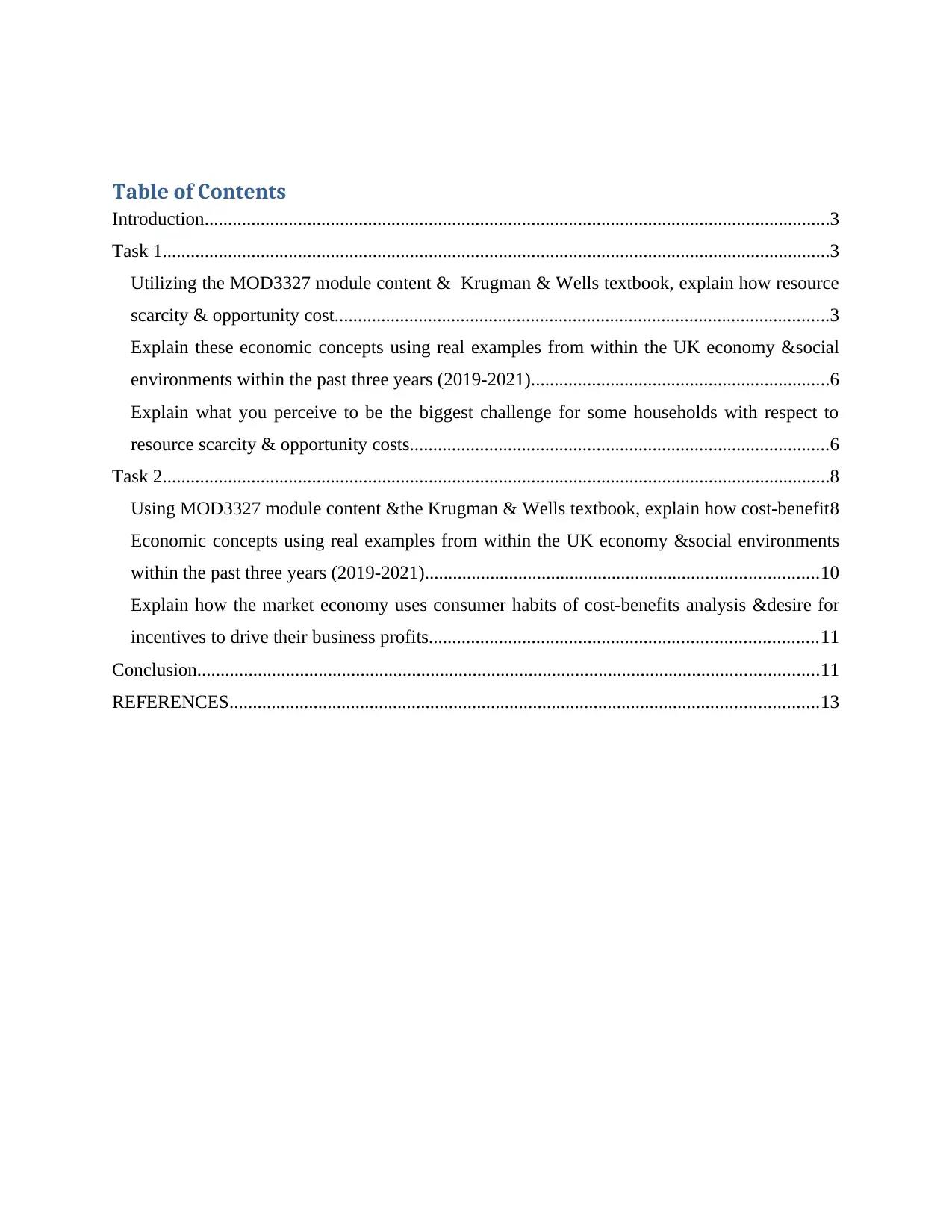
Table of Contents
Introduction......................................................................................................................................3
Task 1...............................................................................................................................................3
Utilizing the MOD3327 module content & Krugman & Wells textbook, explain how resource
scarcity & opportunity cost..........................................................................................................3
Explain these economic concepts using real examples from within the UK economy &social
environments within the past three years (2019-2021)................................................................6
Explain what you perceive to be the biggest challenge for some households with respect to
resource scarcity & opportunity costs..........................................................................................6
Task 2...............................................................................................................................................8
Using MOD3327 module content &the Krugman & Wells textbook, explain how cost-benefit8
Economic concepts using real examples from within the UK economy &social environments
within the past three years (2019-2021)....................................................................................10
Explain how the market economy uses consumer habits of cost-benefits analysis &desire for
incentives to drive their business profits...................................................................................11
Conclusion.....................................................................................................................................11
REFERENCES..............................................................................................................................13
Introduction......................................................................................................................................3
Task 1...............................................................................................................................................3
Utilizing the MOD3327 module content & Krugman & Wells textbook, explain how resource
scarcity & opportunity cost..........................................................................................................3
Explain these economic concepts using real examples from within the UK economy &social
environments within the past three years (2019-2021)................................................................6
Explain what you perceive to be the biggest challenge for some households with respect to
resource scarcity & opportunity costs..........................................................................................6
Task 2...............................................................................................................................................8
Using MOD3327 module content &the Krugman & Wells textbook, explain how cost-benefit8
Economic concepts using real examples from within the UK economy &social environments
within the past three years (2019-2021)....................................................................................10
Explain how the market economy uses consumer habits of cost-benefits analysis &desire for
incentives to drive their business profits...................................................................................11
Conclusion.....................................................................................................................................11
REFERENCES..............................................................................................................................13
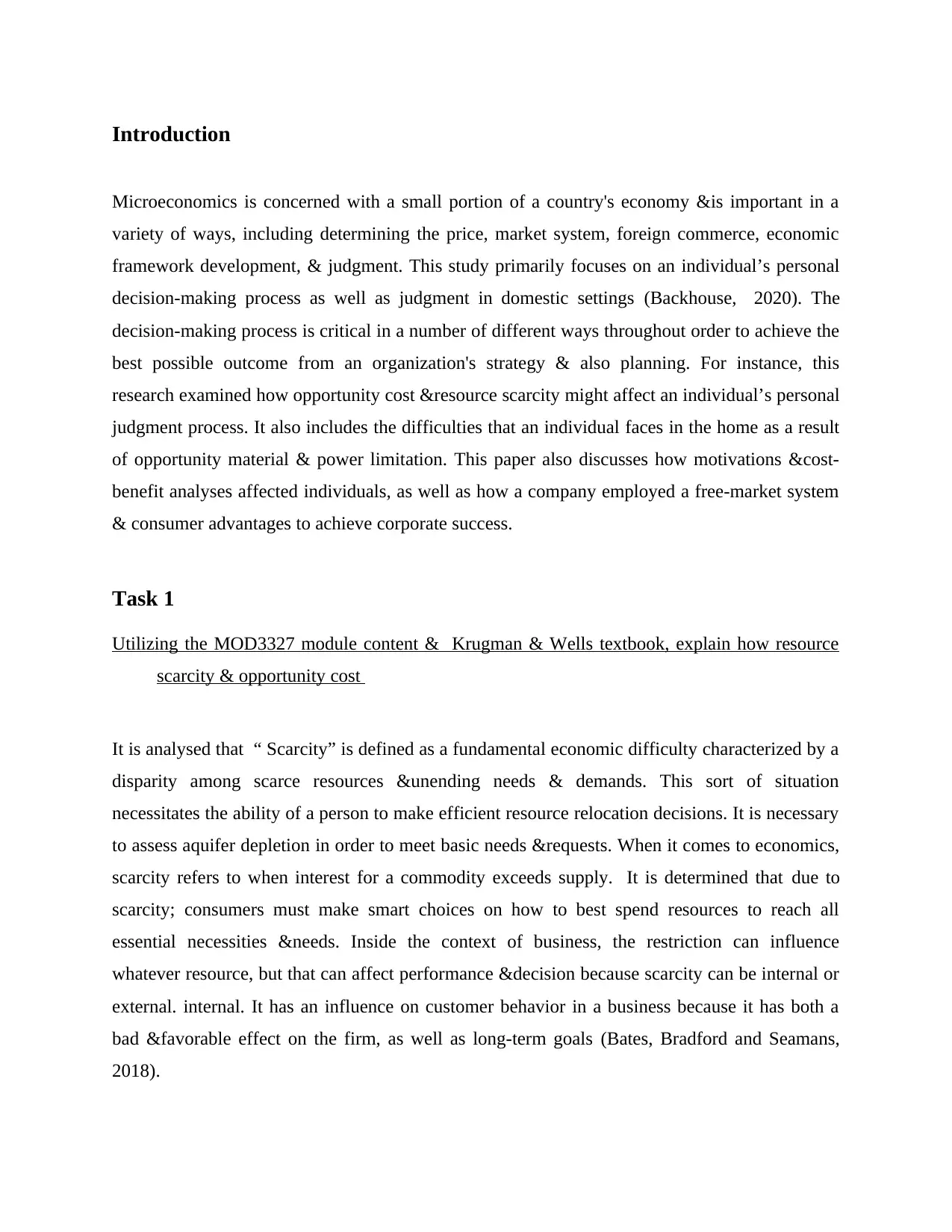
Introduction
Microeconomics is concerned with a small portion of a country's economy &is important in a
variety of ways, including determining the price, market system, foreign commerce, economic
framework development, & judgment. This study primarily focuses on an individual’s personal
decision-making process as well as judgment in domestic settings (Backhouse, 2020). The
decision-making process is critical in a number of different ways throughout order to achieve the
best possible outcome from an organization's strategy & also planning. For instance, this
research examined how opportunity cost &resource scarcity might affect an individual’s personal
judgment process. It also includes the difficulties that an individual faces in the home as a result
of opportunity material & power limitation. This paper also discusses how motivations &cost-
benefit analyses affected individuals, as well as how a company employed a free-market system
& consumer advantages to achieve corporate success.
Task 1
Utilizing the MOD3327 module content & Krugman & Wells textbook, explain how resource
scarcity & opportunity cost
It is analysed that “ Scarcity” is defined as a fundamental economic difficulty characterized by a
disparity among scarce resources &unending needs & demands. This sort of situation
necessitates the ability of a person to make efficient resource relocation decisions. It is necessary
to assess aquifer depletion in order to meet basic needs &requests. When it comes to economics,
scarcity refers to when interest for a commodity exceeds supply. It is determined that due to
scarcity; consumers must make smart choices on how to best spend resources to reach all
essential necessities &needs. Inside the context of business, the restriction can influence
whatever resource, but that can affect performance &decision because scarcity can be internal or
external. internal. It has an influence on customer behavior in a business because it has both a
bad &favorable effect on the firm, as well as long-term goals (Bates, Bradford and Seamans,
2018).
Microeconomics is concerned with a small portion of a country's economy &is important in a
variety of ways, including determining the price, market system, foreign commerce, economic
framework development, & judgment. This study primarily focuses on an individual’s personal
decision-making process as well as judgment in domestic settings (Backhouse, 2020). The
decision-making process is critical in a number of different ways throughout order to achieve the
best possible outcome from an organization's strategy & also planning. For instance, this
research examined how opportunity cost &resource scarcity might affect an individual’s personal
judgment process. It also includes the difficulties that an individual faces in the home as a result
of opportunity material & power limitation. This paper also discusses how motivations &cost-
benefit analyses affected individuals, as well as how a company employed a free-market system
& consumer advantages to achieve corporate success.
Task 1
Utilizing the MOD3327 module content & Krugman & Wells textbook, explain how resource
scarcity & opportunity cost
It is analysed that “ Scarcity” is defined as a fundamental economic difficulty characterized by a
disparity among scarce resources &unending needs & demands. This sort of situation
necessitates the ability of a person to make efficient resource relocation decisions. It is necessary
to assess aquifer depletion in order to meet basic needs &requests. When it comes to economics,
scarcity refers to when interest for a commodity exceeds supply. It is determined that due to
scarcity; consumers must make smart choices on how to best spend resources to reach all
essential necessities &needs. Inside the context of business, the restriction can influence
whatever resource, but that can affect performance &decision because scarcity can be internal or
external. internal. It has an influence on customer behavior in a business because it has both a
bad &favorable effect on the firm, as well as long-term goals (Bates, Bradford and Seamans,
2018).
⊘ This is a preview!⊘
Do you want full access?
Subscribe today to unlock all pages.

Trusted by 1+ million students worldwide
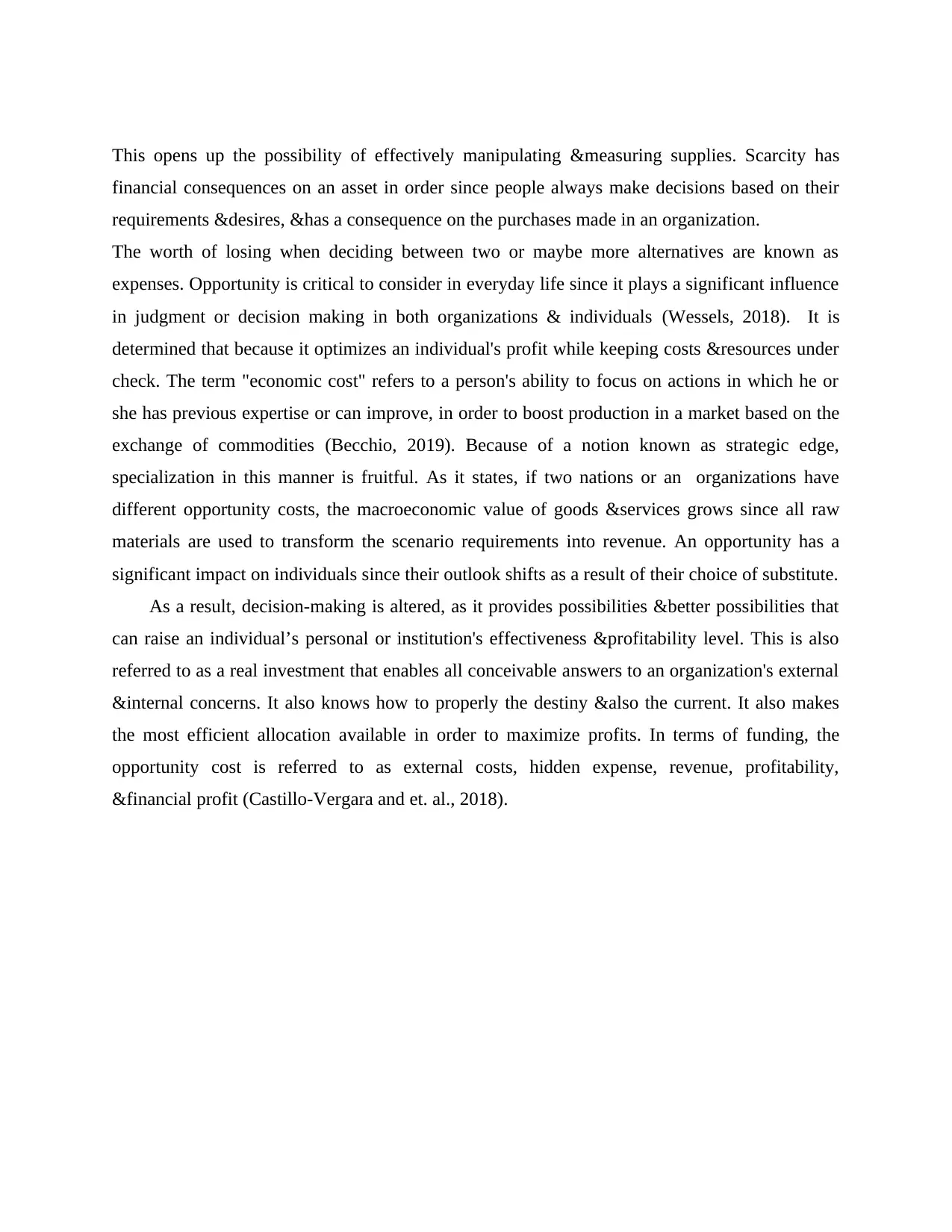
This opens up the possibility of effectively manipulating &measuring supplies. Scarcity has
financial consequences on an asset in order since people always make decisions based on their
requirements &desires, &has a consequence on the purchases made in an organization.
The worth of losing when deciding between two or maybe more alternatives are known as
expenses. Opportunity is critical to consider in everyday life since it plays a significant influence
in judgment or decision making in both organizations & individuals (Wessels, 2018). It is
determined that because it optimizes an individual's profit while keeping costs &resources under
check. The term "economic cost" refers to a person's ability to focus on actions in which he or
she has previous expertise or can improve, in order to boost production in a market based on the
exchange of commodities (Becchio, 2019). Because of a notion known as strategic edge,
specialization in this manner is fruitful. As it states, if two nations or an organizations have
different opportunity costs, the macroeconomic value of goods &services grows since all raw
materials are used to transform the scenario requirements into revenue. An opportunity has a
significant impact on individuals since their outlook shifts as a result of their choice of substitute.
As a result, decision-making is altered, as it provides possibilities &better possibilities that
can raise an individual’s personal or institution's effectiveness &profitability level. This is also
referred to as a real investment that enables all conceivable answers to an organization's external
&internal concerns. It also knows how to properly the destiny &also the current. It also makes
the most efficient allocation available in order to maximize profits. In terms of funding, the
opportunity cost is referred to as external costs, hidden expense, revenue, profitability,
&financial profit (Castillo-Vergara and et. al., 2018).
financial consequences on an asset in order since people always make decisions based on their
requirements &desires, &has a consequence on the purchases made in an organization.
The worth of losing when deciding between two or maybe more alternatives are known as
expenses. Opportunity is critical to consider in everyday life since it plays a significant influence
in judgment or decision making in both organizations & individuals (Wessels, 2018). It is
determined that because it optimizes an individual's profit while keeping costs &resources under
check. The term "economic cost" refers to a person's ability to focus on actions in which he or
she has previous expertise or can improve, in order to boost production in a market based on the
exchange of commodities (Becchio, 2019). Because of a notion known as strategic edge,
specialization in this manner is fruitful. As it states, if two nations or an organizations have
different opportunity costs, the macroeconomic value of goods &services grows since all raw
materials are used to transform the scenario requirements into revenue. An opportunity has a
significant impact on individuals since their outlook shifts as a result of their choice of substitute.
As a result, decision-making is altered, as it provides possibilities &better possibilities that
can raise an individual’s personal or institution's effectiveness &profitability level. This is also
referred to as a real investment that enables all conceivable answers to an organization's external
&internal concerns. It also knows how to properly the destiny &also the current. It also makes
the most efficient allocation available in order to maximize profits. In terms of funding, the
opportunity cost is referred to as external costs, hidden expense, revenue, profitability,
&financial profit (Castillo-Vergara and et. al., 2018).
Paraphrase This Document
Need a fresh take? Get an instant paraphrase of this document with our AI Paraphraser
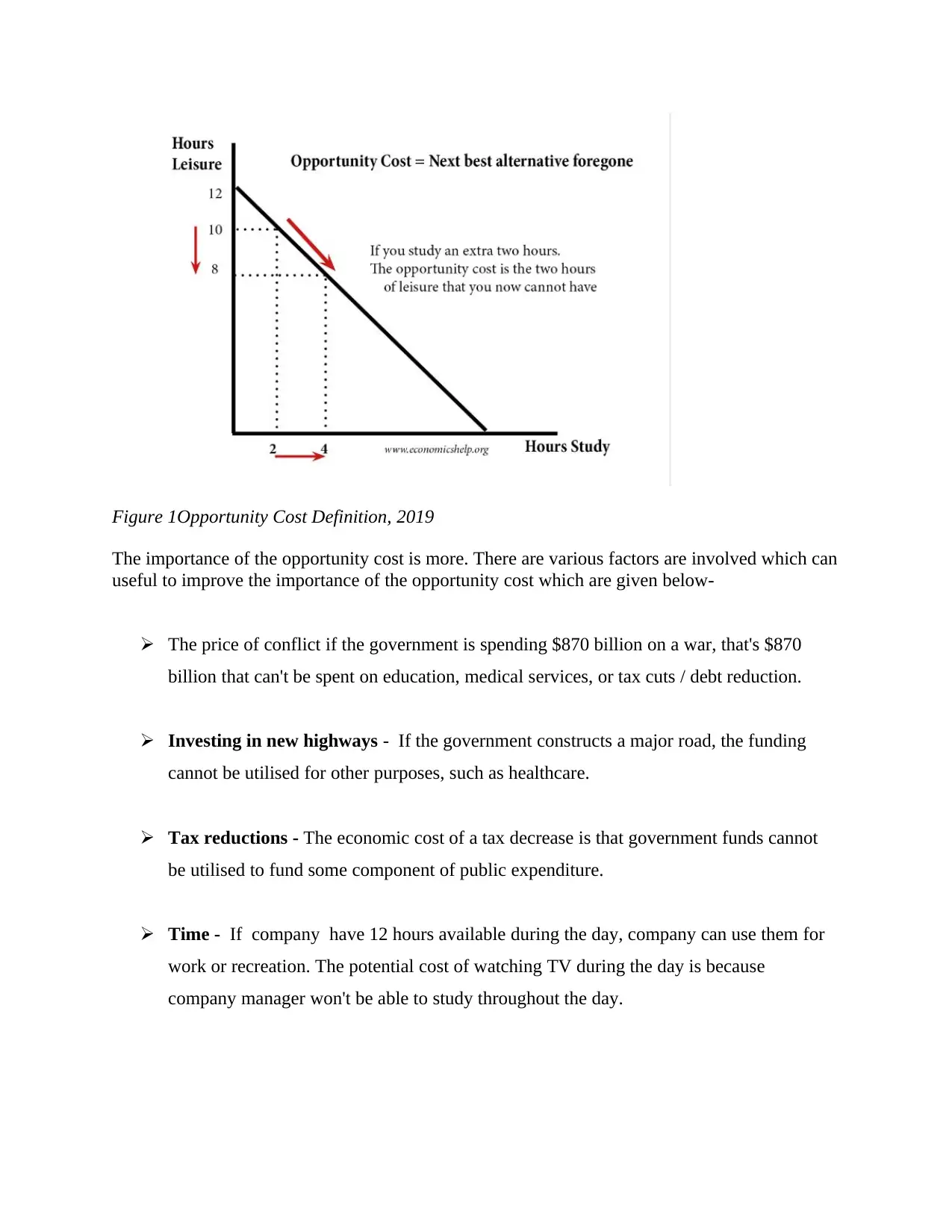
Figure 1Opportunity Cost Definition, 2019
The importance of the opportunity cost is more. There are various factors are involved which can
useful to improve the importance of the opportunity cost which are given below-
The price of conflict if the government is spending $870 billion on a war, that's $870
billion that can't be spent on education, medical services, or tax cuts / debt reduction.
Investing in new highways - If the government constructs a major road, the funding
cannot be utilised for other purposes, such as healthcare.
Tax reductions - The economic cost of a tax decrease is that government funds cannot
be utilised to fund some component of public expenditure.
Time - If company have 12 hours available during the day, company can use them for
work or recreation. The potential cost of watching TV during the day is because
company manager won't be able to study throughout the day.
The importance of the opportunity cost is more. There are various factors are involved which can
useful to improve the importance of the opportunity cost which are given below-
The price of conflict if the government is spending $870 billion on a war, that's $870
billion that can't be spent on education, medical services, or tax cuts / debt reduction.
Investing in new highways - If the government constructs a major road, the funding
cannot be utilised for other purposes, such as healthcare.
Tax reductions - The economic cost of a tax decrease is that government funds cannot
be utilised to fund some component of public expenditure.
Time - If company have 12 hours available during the day, company can use them for
work or recreation. The potential cost of watching TV during the day is because
company manager won't be able to study throughout the day.
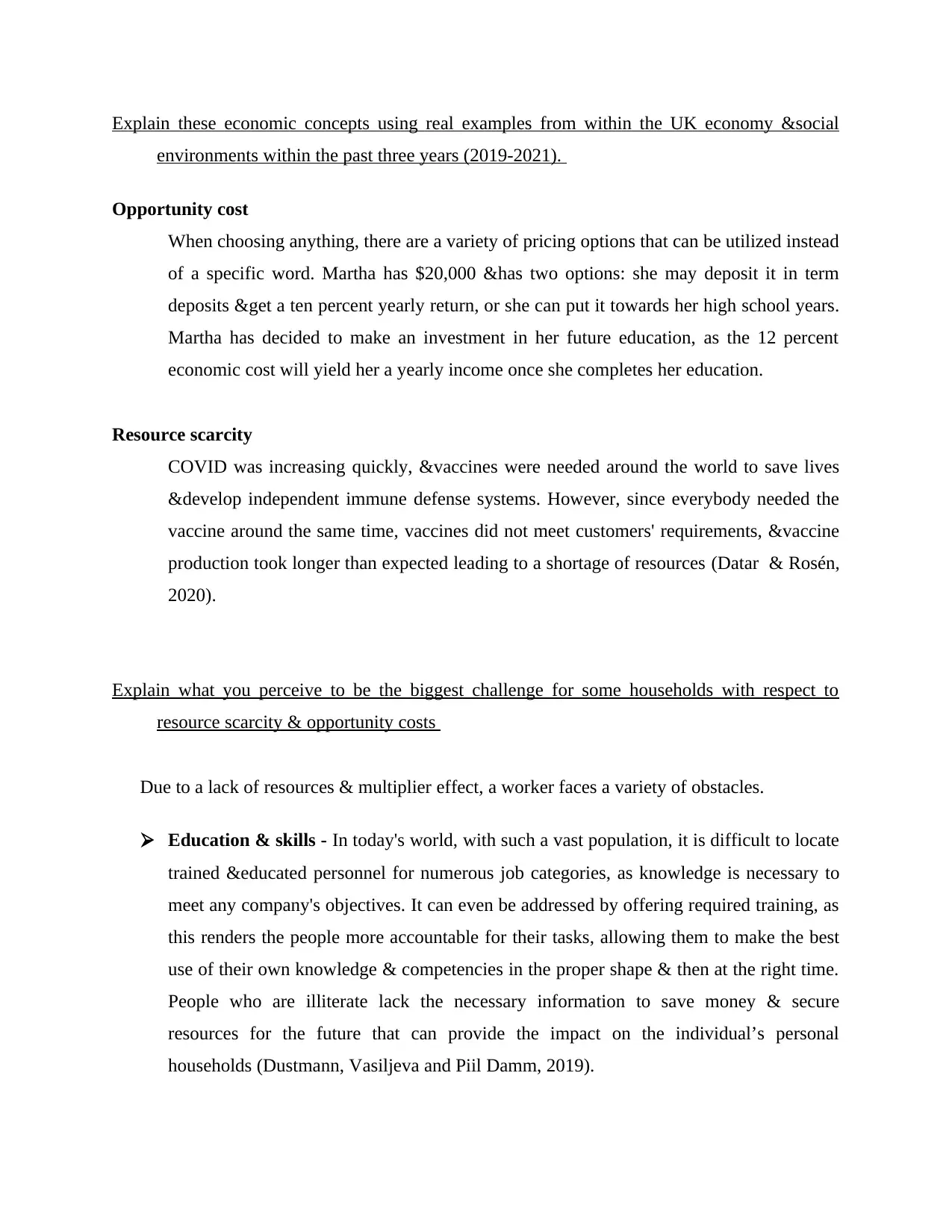
Explain these economic concepts using real examples from within the UK economy &social
environments within the past three years (2019-2021).
Opportunity cost
When choosing anything, there are a variety of pricing options that can be utilized instead
of a specific word. Martha has $20,000 &has two options: she may deposit it in term
deposits &get a ten percent yearly return, or she can put it towards her high school years.
Martha has decided to make an investment in her future education, as the 12 percent
economic cost will yield her a yearly income once she completes her education.
Resource scarcity
COVID was increasing quickly, &vaccines were needed around the world to save lives
&develop independent immune defense systems. However, since everybody needed the
vaccine around the same time, vaccines did not meet customers' requirements, &vaccine
production took longer than expected leading to a shortage of resources (Datar & Rosén,
2020).
Explain what you perceive to be the biggest challenge for some households with respect to
resource scarcity & opportunity costs
Due to a lack of resources & multiplier effect, a worker faces a variety of obstacles.
Education & skills - In today's world, with such a vast population, it is difficult to locate
trained &educated personnel for numerous job categories, as knowledge is necessary to
meet any company's objectives. It can even be addressed by offering required training, as
this renders the people more accountable for their tasks, allowing them to make the best
use of their own knowledge & competencies in the proper shape & then at the right time.
People who are illiterate lack the necessary information to save money & secure
resources for the future that can provide the impact on the individual’s personal
households (Dustmann, Vasiljeva and Piil Damm, 2019).
environments within the past three years (2019-2021).
Opportunity cost
When choosing anything, there are a variety of pricing options that can be utilized instead
of a specific word. Martha has $20,000 &has two options: she may deposit it in term
deposits &get a ten percent yearly return, or she can put it towards her high school years.
Martha has decided to make an investment in her future education, as the 12 percent
economic cost will yield her a yearly income once she completes her education.
Resource scarcity
COVID was increasing quickly, &vaccines were needed around the world to save lives
&develop independent immune defense systems. However, since everybody needed the
vaccine around the same time, vaccines did not meet customers' requirements, &vaccine
production took longer than expected leading to a shortage of resources (Datar & Rosén,
2020).
Explain what you perceive to be the biggest challenge for some households with respect to
resource scarcity & opportunity costs
Due to a lack of resources & multiplier effect, a worker faces a variety of obstacles.
Education & skills - In today's world, with such a vast population, it is difficult to locate
trained &educated personnel for numerous job categories, as knowledge is necessary to
meet any company's objectives. It can even be addressed by offering required training, as
this renders the people more accountable for their tasks, allowing them to make the best
use of their own knowledge & competencies in the proper shape & then at the right time.
People who are illiterate lack the necessary information to save money & secure
resources for the future that can provide the impact on the individual’s personal
households (Dustmann, Vasiljeva and Piil Damm, 2019).
⊘ This is a preview!⊘
Do you want full access?
Subscribe today to unlock all pages.

Trusted by 1+ million students worldwide
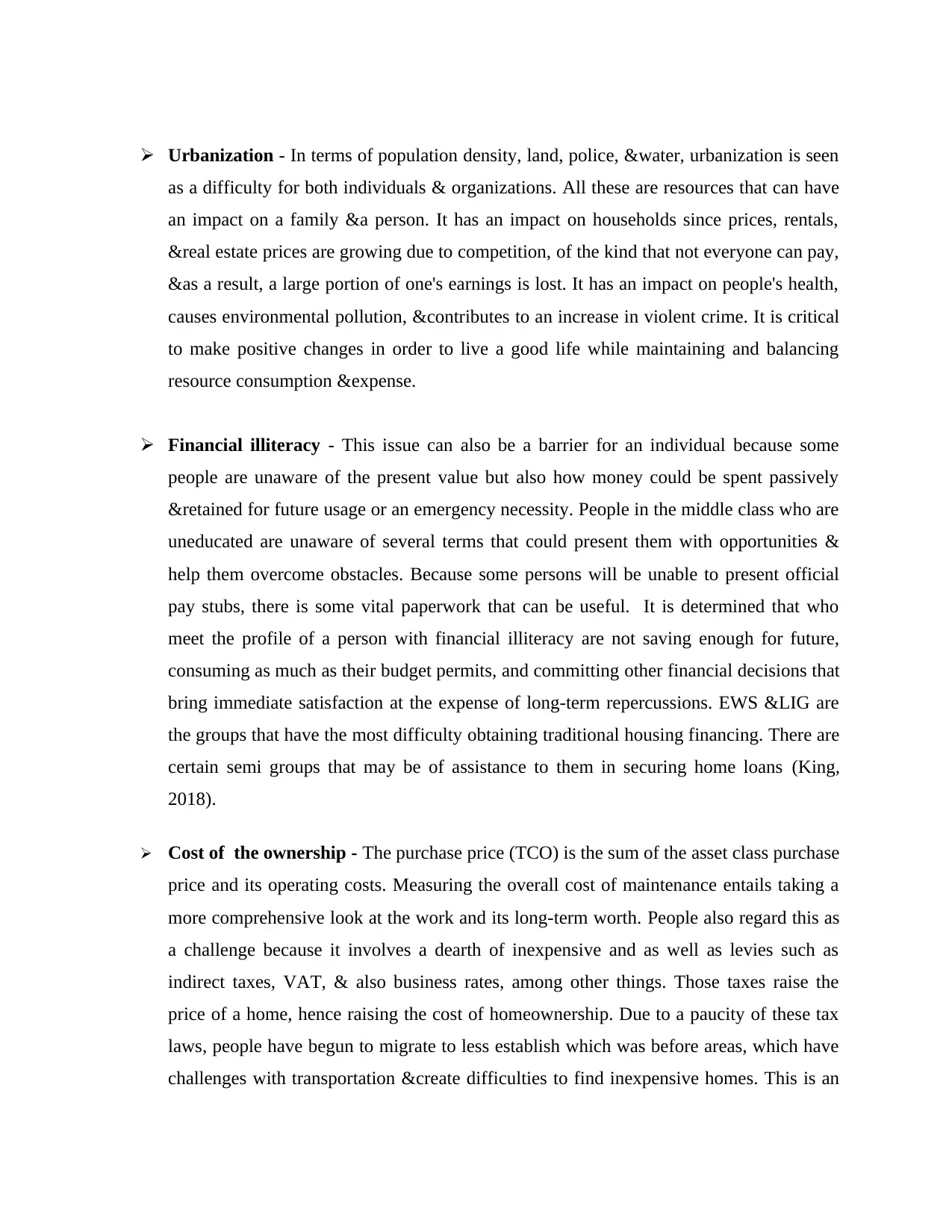
Urbanization - In terms of population density, land, police, &water, urbanization is seen
as a difficulty for both individuals & organizations. All these are resources that can have
an impact on a family &a person. It has an impact on households since prices, rentals,
&real estate prices are growing due to competition, of the kind that not everyone can pay,
&as a result, a large portion of one's earnings is lost. It has an impact on people's health,
causes environmental pollution, &contributes to an increase in violent crime. It is critical
to make positive changes in order to live a good life while maintaining and balancing
resource consumption &expense.
Financial illiteracy - This issue can also be a barrier for an individual because some
people are unaware of the present value but also how money could be spent passively
&retained for future usage or an emergency necessity. People in the middle class who are
uneducated are unaware of several terms that could present them with opportunities &
help them overcome obstacles. Because some persons will be unable to present official
pay stubs, there is some vital paperwork that can be useful. It is determined that who
meet the profile of a person with financial illiteracy are not saving enough for future,
consuming as much as their budget permits, and committing other financial decisions that
bring immediate satisfaction at the expense of long-term repercussions. EWS &LIG are
the groups that have the most difficulty obtaining traditional housing financing. There are
certain semi groups that may be of assistance to them in securing home loans (King,
2018).
Cost of the ownership - The purchase price (TCO) is the sum of the asset class purchase
price and its operating costs. Measuring the overall cost of maintenance entails taking a
more comprehensive look at the work and its long-term worth. People also regard this as
a challenge because it involves a dearth of inexpensive and as well as levies such as
indirect taxes, VAT, & also business rates, among other things. Those taxes raise the
price of a home, hence raising the cost of homeownership. Due to a paucity of these tax
laws, people have begun to migrate to less establish which was before areas, which have
challenges with transportation &create difficulties to find inexpensive homes. This is an
as a difficulty for both individuals & organizations. All these are resources that can have
an impact on a family &a person. It has an impact on households since prices, rentals,
&real estate prices are growing due to competition, of the kind that not everyone can pay,
&as a result, a large portion of one's earnings is lost. It has an impact on people's health,
causes environmental pollution, &contributes to an increase in violent crime. It is critical
to make positive changes in order to live a good life while maintaining and balancing
resource consumption &expense.
Financial illiteracy - This issue can also be a barrier for an individual because some
people are unaware of the present value but also how money could be spent passively
&retained for future usage or an emergency necessity. People in the middle class who are
uneducated are unaware of several terms that could present them with opportunities &
help them overcome obstacles. Because some persons will be unable to present official
pay stubs, there is some vital paperwork that can be useful. It is determined that who
meet the profile of a person with financial illiteracy are not saving enough for future,
consuming as much as their budget permits, and committing other financial decisions that
bring immediate satisfaction at the expense of long-term repercussions. EWS &LIG are
the groups that have the most difficulty obtaining traditional housing financing. There are
certain semi groups that may be of assistance to them in securing home loans (King,
2018).
Cost of the ownership - The purchase price (TCO) is the sum of the asset class purchase
price and its operating costs. Measuring the overall cost of maintenance entails taking a
more comprehensive look at the work and its long-term worth. People also regard this as
a challenge because it involves a dearth of inexpensive and as well as levies such as
indirect taxes, VAT, & also business rates, among other things. Those taxes raise the
price of a home, hence raising the cost of homeownership. Due to a paucity of these tax
laws, people have begun to migrate to less establish which was before areas, which have
challenges with transportation &create difficulties to find inexpensive homes. This is an
Paraphrase This Document
Need a fresh take? Get an instant paraphrase of this document with our AI Paraphraser
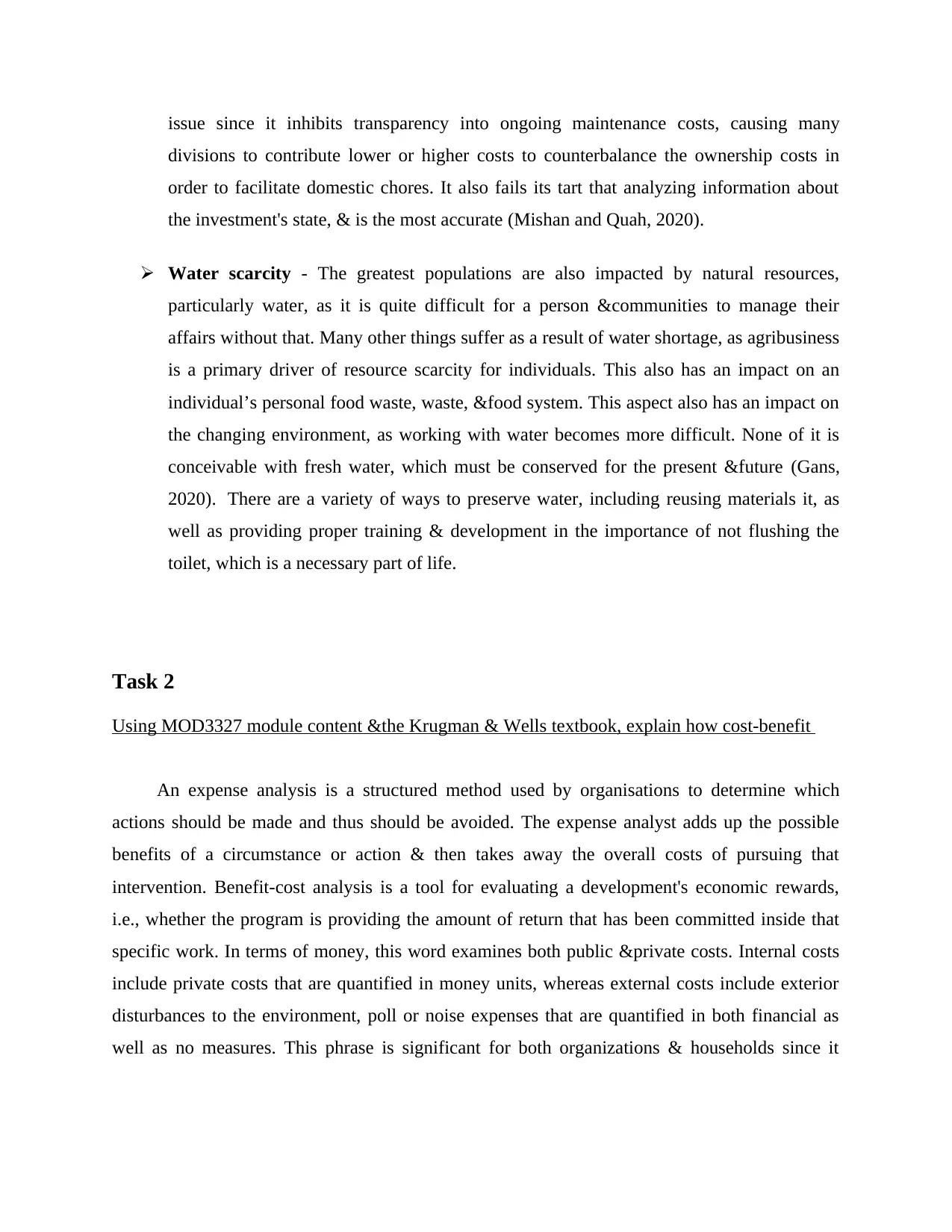
issue since it inhibits transparency into ongoing maintenance costs, causing many
divisions to contribute lower or higher costs to counterbalance the ownership costs in
order to facilitate domestic chores. It also fails its tart that analyzing information about
the investment's state, & is the most accurate (Mishan and Quah, 2020).
Water scarcity - The greatest populations are also impacted by natural resources,
particularly water, as it is quite difficult for a person &communities to manage their
affairs without that. Many other things suffer as a result of water shortage, as agribusiness
is a primary driver of resource scarcity for individuals. This also has an impact on an
individual’s personal food waste, waste, &food system. This aspect also has an impact on
the changing environment, as working with water becomes more difficult. None of it is
conceivable with fresh water, which must be conserved for the present &future (Gans,
2020). There are a variety of ways to preserve water, including reusing materials it, as
well as providing proper training & development in the importance of not flushing the
toilet, which is a necessary part of life.
Task 2
Using MOD3327 module content &the Krugman & Wells textbook, explain how cost-benefit
An expense analysis is a structured method used by organisations to determine which
actions should be made and thus should be avoided. The expense analyst adds up the possible
benefits of a circumstance or action & then takes away the overall costs of pursuing that
intervention. Benefit-cost analysis is a tool for evaluating a development's economic rewards,
i.e., whether the program is providing the amount of return that has been committed inside that
specific work. In terms of money, this word examines both public &private costs. Internal costs
include private costs that are quantified in money units, whereas external costs include exterior
disturbances to the environment, poll or noise expenses that are quantified in both financial as
well as no measures. This phrase is significant for both organizations & households since it
divisions to contribute lower or higher costs to counterbalance the ownership costs in
order to facilitate domestic chores. It also fails its tart that analyzing information about
the investment's state, & is the most accurate (Mishan and Quah, 2020).
Water scarcity - The greatest populations are also impacted by natural resources,
particularly water, as it is quite difficult for a person &communities to manage their
affairs without that. Many other things suffer as a result of water shortage, as agribusiness
is a primary driver of resource scarcity for individuals. This also has an impact on an
individual’s personal food waste, waste, &food system. This aspect also has an impact on
the changing environment, as working with water becomes more difficult. None of it is
conceivable with fresh water, which must be conserved for the present &future (Gans,
2020). There are a variety of ways to preserve water, including reusing materials it, as
well as providing proper training & development in the importance of not flushing the
toilet, which is a necessary part of life.
Task 2
Using MOD3327 module content &the Krugman & Wells textbook, explain how cost-benefit
An expense analysis is a structured method used by organisations to determine which
actions should be made and thus should be avoided. The expense analyst adds up the possible
benefits of a circumstance or action & then takes away the overall costs of pursuing that
intervention. Benefit-cost analysis is a tool for evaluating a development's economic rewards,
i.e., whether the program is providing the amount of return that has been committed inside that
specific work. In terms of money, this word examines both public &private costs. Internal costs
include private costs that are quantified in money units, whereas external costs include exterior
disturbances to the environment, poll or noise expenses that are quantified in both financial as
well as no measures. This phrase is significant for both organizations & households since it
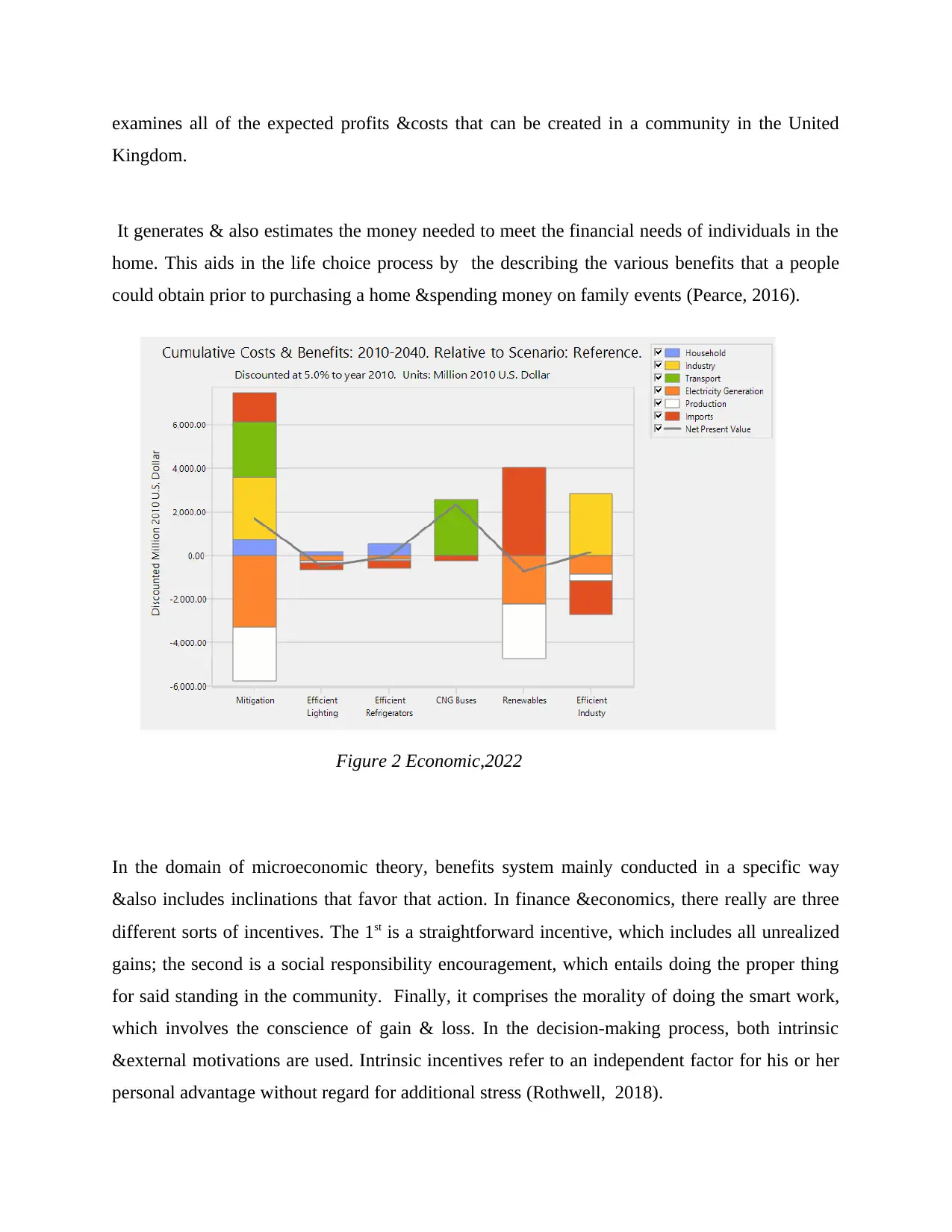
examines all of the expected profits &costs that can be created in a community in the United
Kingdom.
It generates & also estimates the money needed to meet the financial needs of individuals in the
home. This aids in the life choice process by the describing the various benefits that a people
could obtain prior to purchasing a home &spending money on family events (Pearce, 2016).
Figure 2 Economic,2022
In the domain of microeconomic theory, benefits system mainly conducted in a specific way
&also includes inclinations that favor that action. In finance &economics, there really are three
different sorts of incentives. The 1st is a straightforward incentive, which includes all unrealized
gains; the second is a social responsibility encouragement, which entails doing the proper thing
for said standing in the community. Finally, it comprises the morality of doing the smart work,
which involves the conscience of gain & loss. In the decision-making process, both intrinsic
&external motivations are used. Intrinsic incentives refer to an independent factor for his or her
personal advantage without regard for additional stress (Rothwell, 2018).
Kingdom.
It generates & also estimates the money needed to meet the financial needs of individuals in the
home. This aids in the life choice process by the describing the various benefits that a people
could obtain prior to purchasing a home &spending money on family events (Pearce, 2016).
Figure 2 Economic,2022
In the domain of microeconomic theory, benefits system mainly conducted in a specific way
&also includes inclinations that favor that action. In finance &economics, there really are three
different sorts of incentives. The 1st is a straightforward incentive, which includes all unrealized
gains; the second is a social responsibility encouragement, which entails doing the proper thing
for said standing in the community. Finally, it comprises the morality of doing the smart work,
which involves the conscience of gain & loss. In the decision-making process, both intrinsic
&external motivations are used. Intrinsic incentives refer to an independent factor for his or her
personal advantage without regard for additional stress (Rothwell, 2018).
⊘ This is a preview!⊘
Do you want full access?
Subscribe today to unlock all pages.

Trusted by 1+ million students worldwide
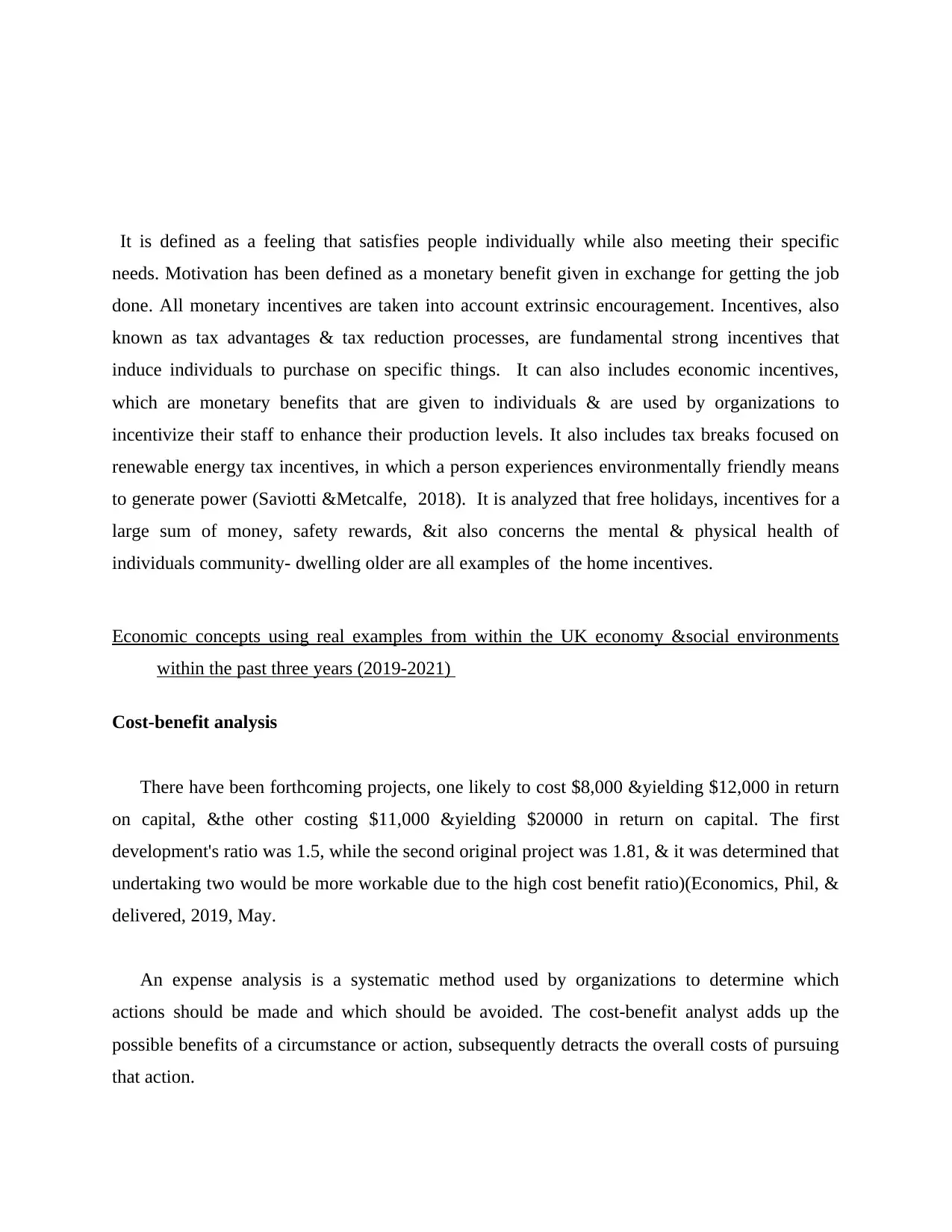
It is defined as a feeling that satisfies people individually while also meeting their specific
needs. Motivation has been defined as a monetary benefit given in exchange for getting the job
done. All monetary incentives are taken into account extrinsic encouragement. Incentives, also
known as tax advantages & tax reduction processes, are fundamental strong incentives that
induce individuals to purchase on specific things. It can also includes economic incentives,
which are monetary benefits that are given to individuals & are used by organizations to
incentivize their staff to enhance their production levels. It also includes tax breaks focused on
renewable energy tax incentives, in which a person experiences environmentally friendly means
to generate power (Saviotti &Metcalfe, 2018). It is analyzed that free holidays, incentives for a
large sum of money, safety rewards, &it also concerns the mental & physical health of
individuals community- dwelling older are all examples of the home incentives.
Economic concepts using real examples from within the UK economy &social environments
within the past three years (2019-2021)
Cost-benefit analysis
There have been forthcoming projects, one likely to cost $8,000 &yielding $12,000 in return
on capital, &the other costing $11,000 &yielding $20000 in return on capital. The first
development's ratio was 1.5, while the second original project was 1.81, & it was determined that
undertaking two would be more workable due to the high cost benefit ratio)(Economics, Phil, &
delivered, 2019, May.
An expense analysis is a systematic method used by organizations to determine which
actions should be made and which should be avoided. The cost-benefit analyst adds up the
possible benefits of a circumstance or action, subsequently detracts the overall costs of pursuing
that action.
needs. Motivation has been defined as a monetary benefit given in exchange for getting the job
done. All monetary incentives are taken into account extrinsic encouragement. Incentives, also
known as tax advantages & tax reduction processes, are fundamental strong incentives that
induce individuals to purchase on specific things. It can also includes economic incentives,
which are monetary benefits that are given to individuals & are used by organizations to
incentivize their staff to enhance their production levels. It also includes tax breaks focused on
renewable energy tax incentives, in which a person experiences environmentally friendly means
to generate power (Saviotti &Metcalfe, 2018). It is analyzed that free holidays, incentives for a
large sum of money, safety rewards, &it also concerns the mental & physical health of
individuals community- dwelling older are all examples of the home incentives.
Economic concepts using real examples from within the UK economy &social environments
within the past three years (2019-2021)
Cost-benefit analysis
There have been forthcoming projects, one likely to cost $8,000 &yielding $12,000 in return
on capital, &the other costing $11,000 &yielding $20000 in return on capital. The first
development's ratio was 1.5, while the second original project was 1.81, & it was determined that
undertaking two would be more workable due to the high cost benefit ratio)(Economics, Phil, &
delivered, 2019, May.
An expense analysis is a systematic method used by organizations to determine which
actions should be made and which should be avoided. The cost-benefit analyst adds up the
possible benefits of a circumstance or action, subsequently detracts the overall costs of pursuing
that action.
Paraphrase This Document
Need a fresh take? Get an instant paraphrase of this document with our AI Paraphraser
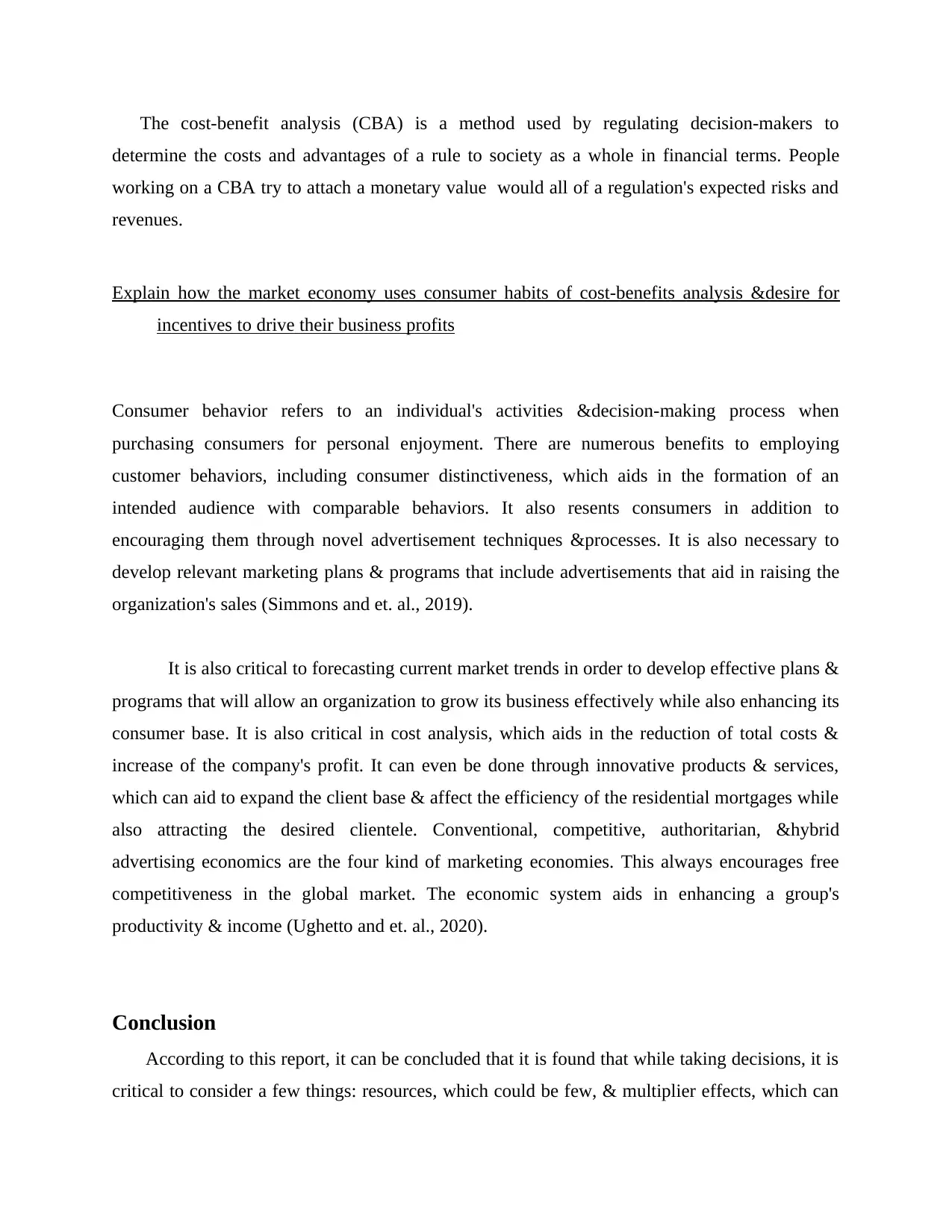
The cost-benefit analysis (CBA) is a method used by regulating decision-makers to
determine the costs and advantages of a rule to society as a whole in financial terms. People
working on a CBA try to attach a monetary value would all of a regulation's expected risks and
revenues.
Explain how the market economy uses consumer habits of cost-benefits analysis &desire for
incentives to drive their business profits
Consumer behavior refers to an individual's activities &decision-making process when
purchasing consumers for personal enjoyment. There are numerous benefits to employing
customer behaviors, including consumer distinctiveness, which aids in the formation of an
intended audience with comparable behaviors. It also resents consumers in addition to
encouraging them through novel advertisement techniques &processes. It is also necessary to
develop relevant marketing plans & programs that include advertisements that aid in raising the
organization's sales (Simmons and et. al., 2019).
It is also critical to forecasting current market trends in order to develop effective plans &
programs that will allow an organization to grow its business effectively while also enhancing its
consumer base. It is also critical in cost analysis, which aids in the reduction of total costs &
increase of the company's profit. It can even be done through innovative products & services,
which can aid to expand the client base & affect the efficiency of the residential mortgages while
also attracting the desired clientele. Conventional, competitive, authoritarian, &hybrid
advertising economics are the four kind of marketing economies. This always encourages free
competitiveness in the global market. The economic system aids in enhancing a group's
productivity & income (Ughetto and et. al., 2020).
Conclusion
According to this report, it can be concluded that it is found that while taking decisions, it is
critical to consider a few things: resources, which could be few, & multiplier effects, which can
determine the costs and advantages of a rule to society as a whole in financial terms. People
working on a CBA try to attach a monetary value would all of a regulation's expected risks and
revenues.
Explain how the market economy uses consumer habits of cost-benefits analysis &desire for
incentives to drive their business profits
Consumer behavior refers to an individual's activities &decision-making process when
purchasing consumers for personal enjoyment. There are numerous benefits to employing
customer behaviors, including consumer distinctiveness, which aids in the formation of an
intended audience with comparable behaviors. It also resents consumers in addition to
encouraging them through novel advertisement techniques &processes. It is also necessary to
develop relevant marketing plans & programs that include advertisements that aid in raising the
organization's sales (Simmons and et. al., 2019).
It is also critical to forecasting current market trends in order to develop effective plans &
programs that will allow an organization to grow its business effectively while also enhancing its
consumer base. It is also critical in cost analysis, which aids in the reduction of total costs &
increase of the company's profit. It can even be done through innovative products & services,
which can aid to expand the client base & affect the efficiency of the residential mortgages while
also attracting the desired clientele. Conventional, competitive, authoritarian, &hybrid
advertising economics are the four kind of marketing economies. This always encourages free
competitiveness in the global market. The economic system aids in enhancing a group's
productivity & income (Ughetto and et. al., 2020).
Conclusion
According to this report, it can be concluded that it is found that while taking decisions, it is
critical to consider a few things: resources, which could be few, & multiplier effects, which can
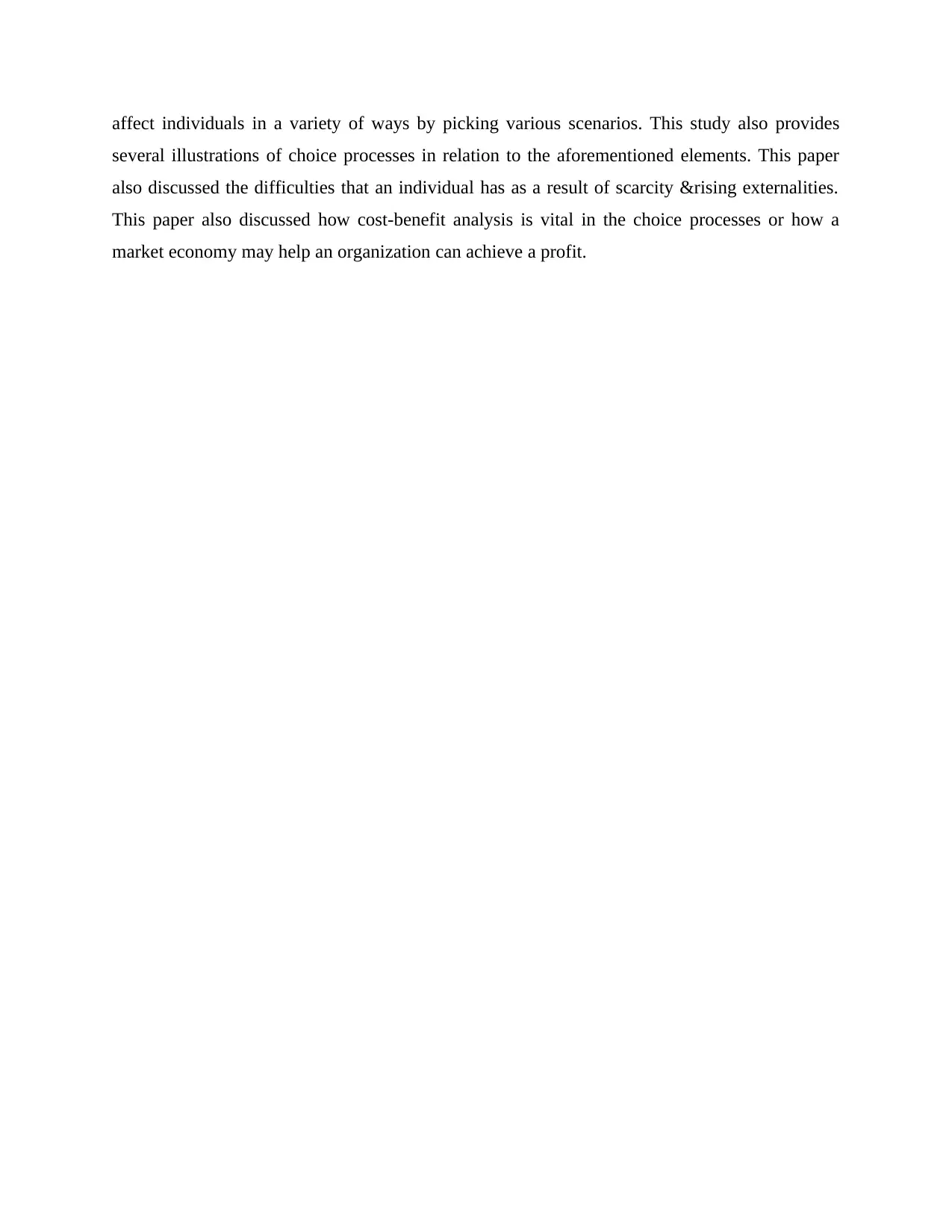
affect individuals in a variety of ways by picking various scenarios. This study also provides
several illustrations of choice processes in relation to the aforementioned elements. This paper
also discussed the difficulties that an individual has as a result of scarcity &rising externalities.
This paper also discussed how cost-benefit analysis is vital in the choice processes or how a
market economy may help an organization can achieve a profit.
several illustrations of choice processes in relation to the aforementioned elements. This paper
also discussed the difficulties that an individual has as a result of scarcity &rising externalities.
This paper also discussed how cost-benefit analysis is vital in the choice processes or how a
market economy may help an organization can achieve a profit.
⊘ This is a preview!⊘
Do you want full access?
Subscribe today to unlock all pages.

Trusted by 1+ million students worldwide
1 out of 14
Related Documents
Your All-in-One AI-Powered Toolkit for Academic Success.
+13062052269
info@desklib.com
Available 24*7 on WhatsApp / Email
![[object Object]](/_next/static/media/star-bottom.7253800d.svg)
Unlock your academic potential
Copyright © 2020–2025 A2Z Services. All Rights Reserved. Developed and managed by ZUCOL.




